Please Take Note: This is a review of the final game, but it might change slightly based on the success of the Kickstarter campaign. The game is being reviewed on the components and the rules provided with the understanding that “what you see is not what you might get” when the game is published. If you like what you read and want to learn more, we encourage you to visit the Kickstarter campaign. Now that we have all that disclaimer junk out of the way, on with the review.

The Basics:
- For ages 10 and up
- For 1 to 5 players
- Approximately 60 minutes to complete
Geek Skills:
- Active Listening & Communication
- Counting & Math
- Logical & Critical Decision Making
- Reading
- Pattern/Color Matching
- Strategy & Tactics
- Cooperative & Team Play
- Hand/Resource Management
Learning Curve:
- Child – Easy
- Adult – Easy
Theme & Narrative:
- The fantasy world has gone to the dogs
Endorsements:
- Gamer Geek mixed!
- Parent Geek approved!
- Child Geek approved!
Overview
American fashion designer, Cynthia Rowley, said “Everything looks cute when it’s small.” Let’s test that theory. Giant undead dragon skeleton 20 feet tall belching hellfire? HOLY CRAP!!! Miniature undead dragon with big eyes and puffing a little wisp of smoke? Adorable! Looks like Ms. Rowley is correct. In this game, danger and daring is around every corner, but so is an almost lethal dose of cuteness.
Fantasy Pug Quest, designed by Alessandro Rivaroli and to be published by Tin Hat Games, will reportedly be comprised of one game mat, 55 Energy cards, five Hero Ability cards, five Hero Character cards, five Boss Ability cards, five Boss Character cards, 20 Treasure cards, 30 Monster cards, five World cards, 30 Damage tokens, 30 Activation tokens, one Time token, and one World token. As this is a review of a prepublished game, I cannot comment on the game component quality. I can, however, comment on the game’s artwork. Artist Mariano De Biase has taken all the fantasy tropes, cliché in every way, and transformed them into the most adorable pups you’d want to put in your purse or satchel. Comical, lighthearted, and highly stylized.

The Corgriffin: deadly and precious
Game Set Up
To set up the game, first place the game mat in the middle of the playing area. Pretty much everything in the game is focused on this mat, so make sure everyone playing can easy reach and see it.
Second, shuffle and randomly draw a Hero card for every player or have each player select a Hero card of their choice. After each player has a Hero card, give to each player the corresponding Hero Sheet card. Place any unused Hero and Hero Sheet cards back in the game box.

“You shall not pass without giving me a scratch behind my ears!”
Third, shuffle the Treasure cards and place it face-down next to the game mat to create the Treasure draw deck. Repeat for the Energy cards, Monster cards and the World cards, creating the Energy, Monster, and World draw decks. Leave room next to each deck for a discard pile.
Fourth, deal to each player a set number of Energy cards. The number of Energy cards dealt is determined by the number of players in the game. These cards go into the player’s hand. Then draw an additional five Energy cards and place them in a row, face-up, next to the game mat and next to the Energy draw deck.
Fifth, place the various tokens into piles (referred to as “pools”).
That’s it for game set up. Time to go on an adorable quest.
Game Play
Fantasy Pug Quest is played in rounds for a total of 10 rounds (or more if the players like). Each round is further divided into turns. A game turn is summarized here.
The game mat has two sections with a numbered track down the middle. The number track records the turns. After ten turns, the round ends. At the start of every round, the Time token should be placed on the “1” spot on the Time track. The World token is placed on the “1” space above the rows, indicating the first of three possible challenges that lie before our doggy-heroes.
On either side of the game mat are two rows with five spaces each. These are reserved for the cards and represents the Monster’s or Hero’s current position. Players now place their Hero card on their side of the game mat. The placement of the Hero card is important, as it represents the Hero’s starting position in combat. Beefy warriors should be placed towards the Time track, with the more squishy and less combat-ready adventurers placed in the rear, behind their more burly companions.
One player now draws the top-most World card from the World draw deck. The World card add special rules to the round and define the starting Monster positions. The World deck tells the players the number of Monster cards to draw (and Boss card if final world) and the position on the opposite rows of the Heroes the Monster cards are positioned.
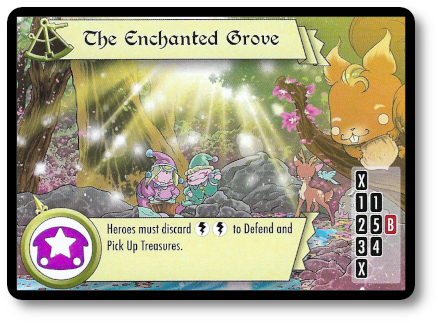
This is where diabetes comes from…so sickeningly sweet
The round is now resolved, starting with the Hero, Monster, or Boss Monster with the highest initiative score value, followed by the next highest and so on until every Hero, Monster, and Boss Monster have had a turn (or they would have, if it weren’t for the annoying fact that they were dead). If a tie occurs, the faction (Hero versus Monster) with the most cards currently in play goes first.
The Heroes Advance!
When it’s a player’s turn, they can take up to two actions. These actions are as follows and can be performed multiples times (except for Standard Attack).
- Move: Movement is tracked by shifting cards from one position to anther in the rows and columns. The card can move as many open spaces as possible based on the card’s listed Movement value. Heroes shift positions in the game, swapping out from one row and column to another. The same goes for Monsters.
- Standard Attack: The Hero takes a swipe at a nearby Monster and inflicts basic damage (in this case, one point). To do so, an Energy card must be discarded that matches the Hero’s energy. Energy comes in the forms of Strength, Speed, Intellect, Spirit, Magic, and Jolly (which is considered “wild” Energy that can substitute for any other Energy type). The energy associated withe the Hero is based on the Hero’s class. For example, the Warrior favors the energy of Strength. This action can only be completed once per turn. Heroes can attack over fellow Heroes.
- Draw: The player draws two Energy cards. These can be taken from the Energy draw deck (blind), from the Energy cards face-up in a row, or any combination of the two.
- Discard: The player can discard any number of Energy cards from their hand and draw an equal number back into their hand.
A player always has access to the following free actions:
- Pick Up: A defeated Monster drops treasure (convenient!). Any Hero on the same line of the opposite column as the defeated Monster may pick it up by discarding treasuring using an Energy card that matches the Monster type.
- Defend: When a Monster attacks a Hero, the player can discard any number of Energy cards that match the Monster type to deflect it.
- Combo: A combo can be performed against a Monster per the combo description.
The Heroes (and Monsters) Attack!
Combat is pretty simple. When a Hero (or Monster) performs the Standard Attack, damage is inflicted. Players can use Energy cards to create combos and Treasure cards (as a free action) to boost their attacks. As noted, the same Energy is used to defend (so don’t go crazy with your Energy, kids). Damage is tracked by placing the Damage tokens on the cards. When a card has enough damage equal to or greater than the listed Life value, the card is considered “defeated”.
Monsters attack after they move (if they move). Monsters don’t use Energy. They just attack, inflicting damage on the closest Hero (or as noted on the Monster card), doing one or more points of damage. Like Heroes, Monsters can attack over the heads of other Monsters. Monsters move in a set direction and a set number of spaces (as indicated on the Monster card).
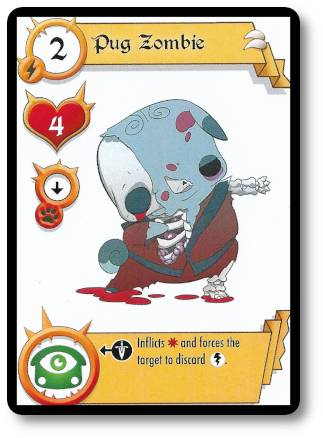
Someone wants a hug…
Boss Monsters are a bit different and come with their own character sheet. The same rules more or less apply for Boss Monsters as they do for everyday Monsters, but anything noted on the Boss Monster card trumps any other rules in the game.
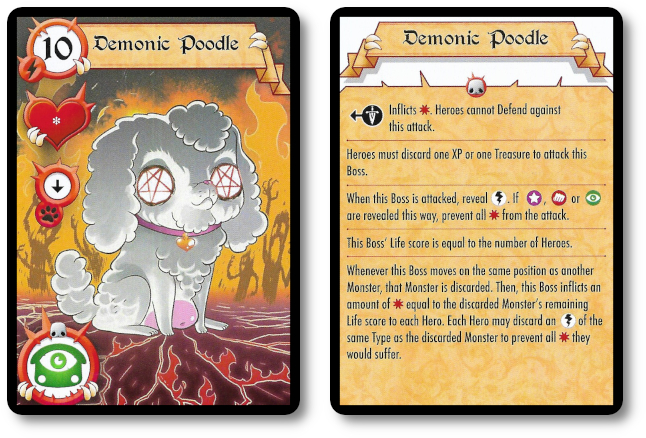
Honestly, poodles are already unsettling…this just compounds that fact
When a Monster is defeated, it’s removed and given to the player who defeated it as a grisly trophy. The defeated Monster is now considered earned Experience Points. The defeated Monster will also drop treasure, which allows the players to draw a Treasure card.
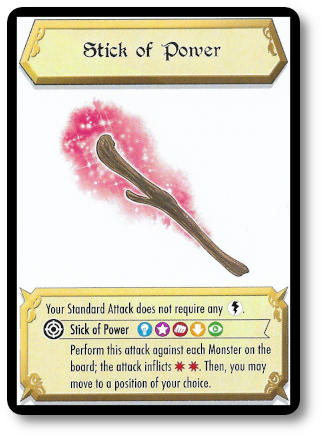
Go fetch!
When a Hero is defeated, the player removes their Hero from the game mat and discards all their Treasure and Energy cards. Experience points (i.e. “defeated Monster cards”) are kept. The good news is that you can’t keep a good Hero down. The player is able to get back in the action in the next round, but can take no additional turns in the current round.
The Heroes Level Up!
As the player defeats Monsters, Experience Points are earned. When they earn enough, they gain access to Combos (as noted on their Hero Sheet card). In this way, the player’s Hero becomes more powerful. But more power means the need for more Energy. The player will always have access to their most basic actions. Using their newly acquired and much more powerful abilities will require the player to think carefully about what cards they have in their hand, as each player has a limited number of cards they can hold.
A Turn Ends, Another Begins
Once all players and all the Monsters have gone (based on their Initiative value), the turn ends. The Time token advances and a new turn now begins. The Round ends at the end of the tenth turn.
Ending the Game
The game can end a few different ways.
If all the Heroes are defeated (total party wipe-out), then the round comes to an end. Likewise, if all the Monsters are defeated, the round ends but in the Heroes favor.
The players can end the game now, deciding to complete the adventure in only one world. Optionally, they can continue to the next world (for a total of three worlds). Moving to the next world will cost the players Energy cards (representing travel, I suppose), but the players get to shop at the World Market (which means the players get to buy cards from the Treasure deck). Only Heroes who survive get to do so, however. If a Hero is defeated during the adventure in one world, they don’t get to shop before venturing to the next.
Ultimately, the game is really won if the players venture through all three worlds and defeat the Boss Monster they encounter at the very end. But as noted, players can just have a quick adventure, too. In which case, I suppose winning means surviving.
To learn more about Fantasy Pug Quest, visit the Kickstarter campaign.
Final Word
 The Child Geeks loved the art and the game. According to one Child Geek, “I think these little doggies are so adorable! I want to just pick them up and pat them on the head and rub their belly, but I’m not sure my pug warrior would like that.” Another Child Geek said, “I like how you can play together to win, just like a real fantasy hero party. Plus, you get to be a dog and fight dog zombies. That’s pretty good, too.” All of the Child Geeks understood how to play, and if any didn’t, the rest of the players lent a hand. Since the game is cooperative, players can take their time, talk about what should (or should not) be done, and then share details about what is available to them. This made teaching the game very easy and bringing new players up to speed even easier. When all the dogs returned home, wagging their tails, the Child Geeks voted to approve Fantasy Pug Quest.
The Child Geeks loved the art and the game. According to one Child Geek, “I think these little doggies are so adorable! I want to just pick them up and pat them on the head and rub their belly, but I’m not sure my pug warrior would like that.” Another Child Geek said, “I like how you can play together to win, just like a real fantasy hero party. Plus, you get to be a dog and fight dog zombies. That’s pretty good, too.” All of the Child Geeks understood how to play, and if any didn’t, the rest of the players lent a hand. Since the game is cooperative, players can take their time, talk about what should (or should not) be done, and then share details about what is available to them. This made teaching the game very easy and bringing new players up to speed even easier. When all the dogs returned home, wagging their tails, the Child Geeks voted to approve Fantasy Pug Quest.
 The Parent Geeks found the game to be just the right mix of humor and seriousness. According to one Parent Geek, “Yes, the game is quirky and the artwork makes even the undead dog look like something you would want to pet on your lap – which is weird – but there is a real game here. If players don’t work together, they will get swamped by adorable and flesh-hungry cuteness.” Another Parent Geek said, “The game does a great job of putting just enough in and out of the player’s hands. Which, to me, lets me concentrate on my game plan, letting the rest of the game play itself out.” The Parent Geeks found that Fantasy Pug Quest was fun to play with their friends, with their family, and the combination of the two. Most importantly, they found it to be a game they could all agree to adoring.
The Parent Geeks found the game to be just the right mix of humor and seriousness. According to one Parent Geek, “Yes, the game is quirky and the artwork makes even the undead dog look like something you would want to pet on your lap – which is weird – but there is a real game here. If players don’t work together, they will get swamped by adorable and flesh-hungry cuteness.” Another Parent Geek said, “The game does a great job of putting just enough in and out of the player’s hands. Which, to me, lets me concentrate on my game plan, letting the rest of the game play itself out.” The Parent Geeks found that Fantasy Pug Quest was fun to play with their friends, with their family, and the combination of the two. Most importantly, they found it to be a game they could all agree to adoring.
 The Gamer Geeks approved of the obvious humor of the game and its theme, but they had some reservations on the game play. According to one Gamer Geek, “The game is well designed and easy to follow. Full points there. Since it’s a cooperative, the game felt really easy. Everything we would be fighting was visible. No surprises. No real dangers. We won every time because it was obvious what we had to do to win. The only real difficulty was managing the cards, but that isn’t too difficult either if you just give it a bit of thought.” Another Gamer Geek said, “I never felt stressed, but I did laugh a lot. I never felt challenged, but I was always engaged. I’d play this game again, but I don’t know if I would necessarily seek it out if I wanted a game that really challenged me. I think this game is best if you want to play and be social at the same time.” All the Gamer Geeks agreed the game was a good one, but were mixed when it came to deciding if it was a game for the elitists, resulting in a mixed endorsement.
The Gamer Geeks approved of the obvious humor of the game and its theme, but they had some reservations on the game play. According to one Gamer Geek, “The game is well designed and easy to follow. Full points there. Since it’s a cooperative, the game felt really easy. Everything we would be fighting was visible. No surprises. No real dangers. We won every time because it was obvious what we had to do to win. The only real difficulty was managing the cards, but that isn’t too difficult either if you just give it a bit of thought.” Another Gamer Geek said, “I never felt stressed, but I did laugh a lot. I never felt challenged, but I was always engaged. I’d play this game again, but I don’t know if I would necessarily seek it out if I wanted a game that really challenged me. I think this game is best if you want to play and be social at the same time.” All the Gamer Geeks agreed the game was a good one, but were mixed when it came to deciding if it was a game for the elitists, resulting in a mixed endorsement.
 Fantasy Pug Quest isn’t ground breaking, but it’s certainly fun. The most fun I had was with casual and younger players. I think the game is perfect for them. There is a good mix of humor and fun that blends well with the strategy and tactics required by the players to win as a team. To the Gamer Geeks’ point, nothing in Fantasy Pug Quest will overly challenge the players if they keep focused in on the big threats and talk it through. Since the world is set up with the threat right up front, the players know exactly how big the challenge will be before they even start. This works great for casual and new players, giving them time to think and consider how they should approach the monsters. For gamers who are looking for the game to challenge them, they found that Fantasy Pug Quest focused more on the team play and fun rather than the team pain and difficulty.
Fantasy Pug Quest isn’t ground breaking, but it’s certainly fun. The most fun I had was with casual and younger players. I think the game is perfect for them. There is a good mix of humor and fun that blends well with the strategy and tactics required by the players to win as a team. To the Gamer Geeks’ point, nothing in Fantasy Pug Quest will overly challenge the players if they keep focused in on the big threats and talk it through. Since the world is set up with the threat right up front, the players know exactly how big the challenge will be before they even start. This works great for casual and new players, giving them time to think and consider how they should approach the monsters. For gamers who are looking for the game to challenge them, they found that Fantasy Pug Quest focused more on the team play and fun rather than the team pain and difficulty.
What this comes down to is preference. Fantasy Pug Quest is a solid game. Great artwork, intelligent rules, and meaningful game play. Where the game will or will not be successful is dependent on the mood at the gaming table. Those players looking for a difficult game where defeat is an absolute certainty if you don’t have your game face-on will quickly see that Fantasy Pug Quest wants the players to have fun more than be overly challenged. It isn’t super-easy by any means, but it’s also a pretty smooth ride. Those looking for bumps and pitfalls will find the game lacks a strong bite. This is a game that likes to playfully nibble.
But this is also a plus for the game. It does challenge the players and you can lose if you don’t play smart. There is just enough demand on the players to make them stop and think, but not enough to make them stop and freeze. No choice in the game feels fatal or heavy. Add in the cooperative element and every player has friends at the table to talk strategy and tactics through, making each player turn an exercise is partnership and joint-decision making. This reduces a lot of stress and anxiety, giving the players the freedom to relax, have fun, and just enjoy the comradery that comes with playing a game about bad-ass pups.
If you like fantasy games and feel that the genre has taken a dark turn – or worse – is just about fighting ugly things, do take a look at Fantasy Pug Quest. It takes all the fun in a fantasy world and adventure, sprinkles sugar on it, and delivers a sweet game. For those looking for guts and glory, you’ll find this game to be lacking the sourness of defeat. One thing everyone can agree upon, regardless of their game preference, is that Fantasy Pug Quest has one of the most disturbing Boss Monster you’ll ever encounter.
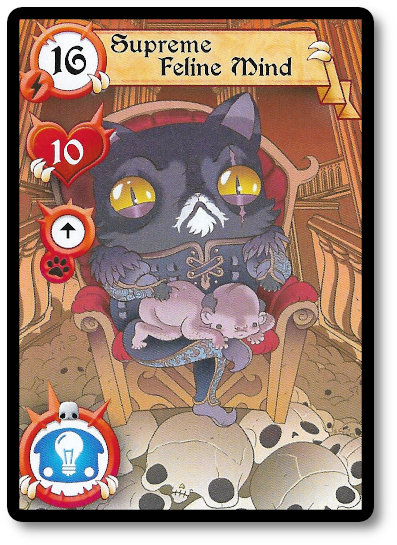
Yep. That’s a naked bald man in the cat’s lap. Note the hand position…. (⊙_⊙’)
This is a paid for review of the game’s final prototype. Although our time and focus was financially compensated, our words are our own. We’d need at least 10 million dollars before we started saying what other people wanted. Such is the statuesque and legendary integrity of Father Geek which cannot be bought except by those who own their own private islands and small countries.



